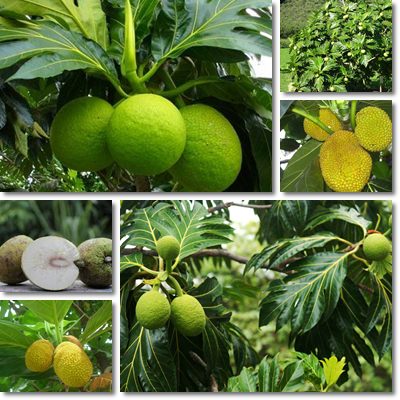A popular tropical staple, breadfruit (Artocarpus altilis) is an excellent source of important nutrients such as vitamin C, potassium, thiamine, pantothenic acid, vitamin B6, magnesium and niacin, dietary fiber and potent antioxidants with wonderful therapeutic properties. Although rich in calories, breadfruit boasts several impressive health benefits, notably glucose control, blood pressure and cholesterol reduction, improved intestinal motility and digestion, constipation relief, skin and hair care and antioxidant protection.
The leaves and flowers of the species are also favorite folk remedies for treating asthma and tooth aches, while the fruit is used as a natural insect repellent. Breadfruit is a tree species in the Moraceae family, meaning it is related to mulberries, Osage orange and figs (also see the benefits of mulberries). While they may look nothing alike, the species are characterized by the fact that they all produce compound fruit. These are fruit that merge together into a bigger fruit (examples: pineapple, raspberries).

What does breadfruit look like?
Breadfruit is a compound fruit, meaning the chunky fruit we pick from the tree is actually made up of numerous smaller fruit fused together into a bigger false fruit. Breadfruit are about the size of a grapefruit and have a distinctive bright green color that changes to a soft yellow, sometimes brown as the fruit matures. The fruit is connected to the tree branch by means of a longer or shorter green stalk.
The leaves are large and multilobed and have a beautiful deep green color and smooth surface. Different varieties are characterized by different shapes, skin textures and either the presence or absence of seeds.
Breadfruit can have a round, oval, ovoid, oblong, heart-shaped or an irregular shape and may or may not have seeds. Skin texture may be smooth, rough, with either flat or prominent bumps, hard spike or flexible spines. Overall, it looks a lot like a jackfruit (see the benefits of jackfruit). Some breadfruit varieties are seedless. Others contain a variable numbers of 1-3 cm long, round or ovoid seeds that range in color from creamy white to dark brown. Ripe fruit have smooth either white or yellow flesh. Unripe fruit ooze a milky white latex if cut.
What does breadfruit taste and smell like?
Breadfruit flesh, peel and seeds are edible, but the peel is often discarded prior to consumption. As its name hints, breadfruit is quite starchy and bland, like bread. The cooked fruit tastes similar to artichoke hearts or potatoes, undercooked ones many people say, or freshly baked bread. Some breadfruit varieties have a slightly sweet taste and a freshly baked bread smell to them as a result of the fruit’s high starch content which turns into sugar during ripening.
While it can be eaten raw, most people prefer it cooked as they can season it properly and give it more taste. The fruit can be boiled, fried, roasted, baked or steamed, according to preference. The seeds can be eaten together with the rest of the fruit or cooked separately. They are often roasted, boiled or ground and are said to have a chestnut flavor.
See also : Jackfruit vs Breadfruit

What are the benefits of breadfruit?
Most of the fruit’s benefits stem from its nutrient, antioxidant and dietary fiber content, with macronutrients playing a secondary part. Find out what are the 9 most noteworthy nutrition facts and health benefits of breadfruit.
Helps with blood pressure control
100 g of raw breadfruit provides about 490 mg of dietary potassium, a mineral that regulates body fluids and blood pressure. Regular consumption of potassium-rich foods is ideal for lowering high blood pressure. Breadfruit also contains generous amounts of vitamin C which helps clean arteries, further contributing to cardiovascular health.
Contributes to lowering cholesterol
100 g of raw breadfruit contain 4.9 g of dietary fiber. Dietary fiber binds to fat and prevents our intestines from absorbing too much of it, indirectly contributing to lower LDL (bad) cholesterol and triglyceride levels.
Contributes to glycemic control
The high amounts of dietary fiber in breadfruit (4.9 g) are believe to decrease the intestinal absorption of sugars, contributing to a better glycemic control and possibly lower blood glucose levels, potentially reducing the risk of hyperglycemia and type 2 diabetes.
Digestive benefits
Eating breadfruit improves intestinal motility and digestion and relieves constipation. As a result of its generous dietary fiber content, breadfruit regulates intestinal motility and bowel movement frequency, improving digestive tract health and relieving constipation naturally.
Boosts energy levels
Breadfruit is a generous source of B group vitamins, notably thiamine (0.11 mg), pantothenic acid (457 mg), vitamin B6 and niacin, which are directly responsible for macronutrient synthesis and energy production. Having enough B vitamins in your diet has a highly beneficial effect on energy levels and productivity. Moreover, breadfruit provides 103 kcal/100 g of fruit, further boosting energy levels.
Great source of amino acids
Breadfruit is a source of high-quality protein because it provides all essential amino acids (Breadfruit (Artocarpus altilis): a source of high-quality protein for food security and novel food products). Amino acids build proteins and proteins build muscles, organs, tendons, etc. and perform a bewildering variety of other life-sustaining functions within our body, hence their dietary importance.
Rich in vitamin C and copper
100 g of breadfruit provides 29 mg of vitamin C, a potent natural anti-inflammatory, antiviral and antioxidant. Vitamin C protects against free radical damage and reduces inflammation markers in the body, reducing chronic disease risks. Breadfruit is also a good source of dietary copper, a mineral that contributes to thyroid health, hair and eyes pigmentation and connective tissue health.
Great source of antioxidants
Breadfruit was found to be a great source of bioactive polyphenolic compounds with potent antimicrobial and antioxidant benefits (Evaluation of antioxidant, total phenol and flavonoid content and antimicrobial activities of Artocarpus altilis (breadfruit) of underutilized tropical fruit extracts). Pulp extract were found to inhibit Salmonella typhimurium, Escherichia coli, Klebsiella pneumonia and Candida albicans cultures, among others.
Supports collagen production
According to research, breadfruit extract supports the activity of fibroblasts, cells that produce collagen, a protein responsible for tissue regeneration (Evaluation of the effect of Thai breadfruit’s heartwood extract on the biological functions of fibroblasts from wrinkles). Collagen production is essential for wrinkle prevention and skin rejuvenation as collagen is responsible for skin structure and skin elasticity.
